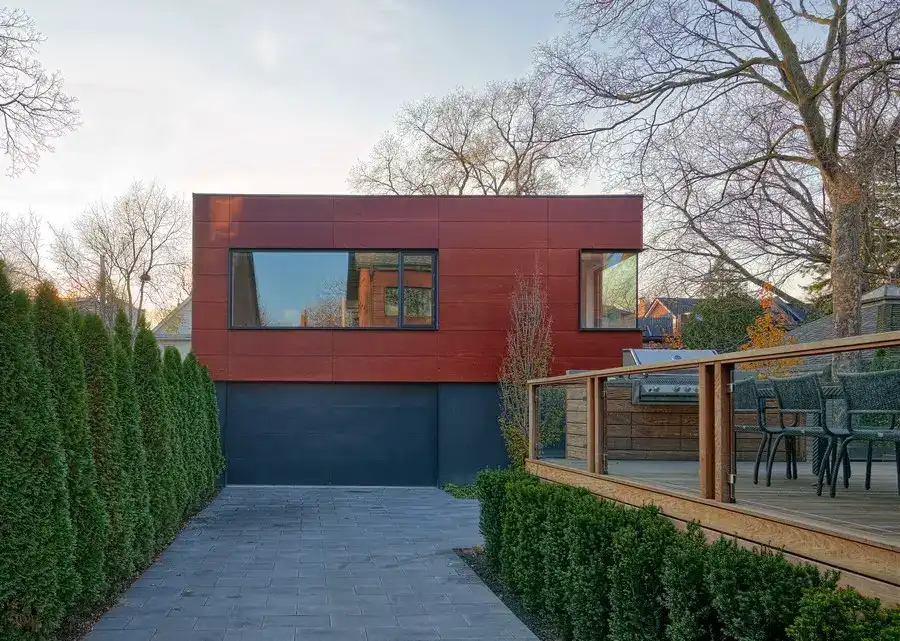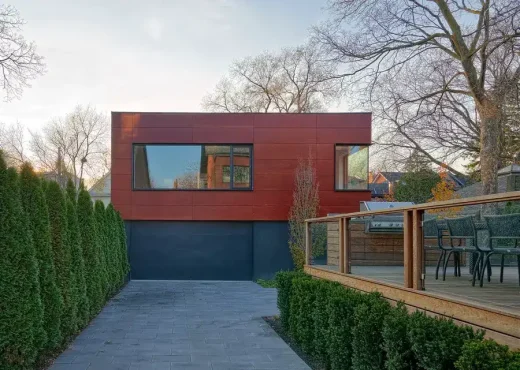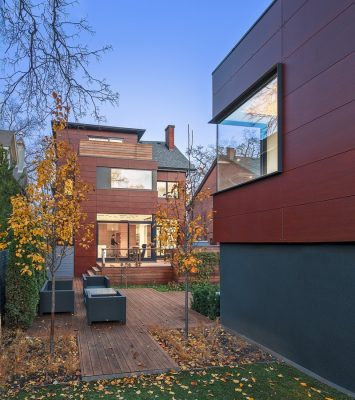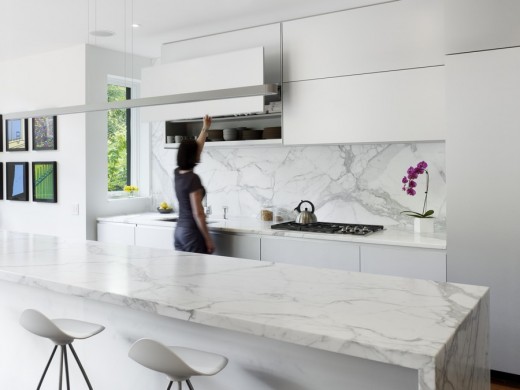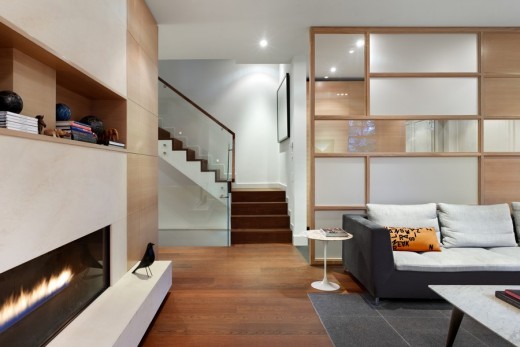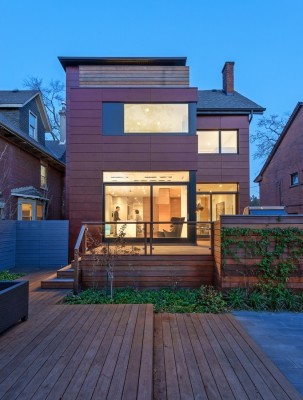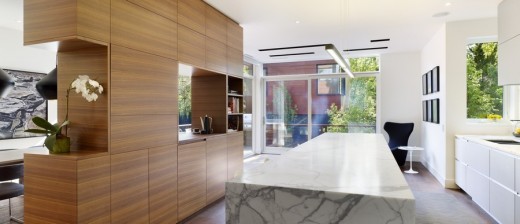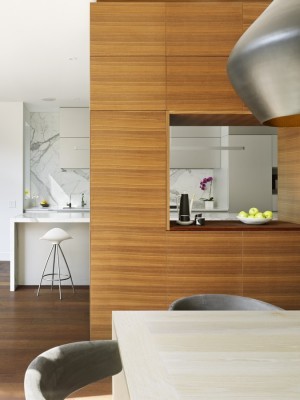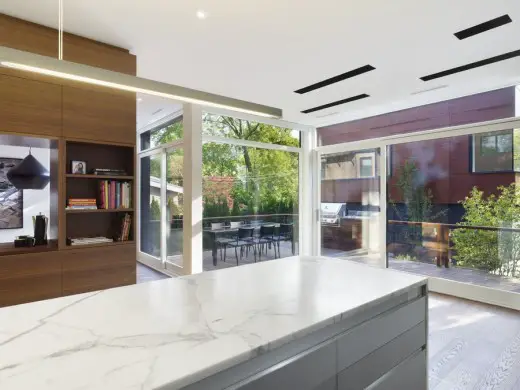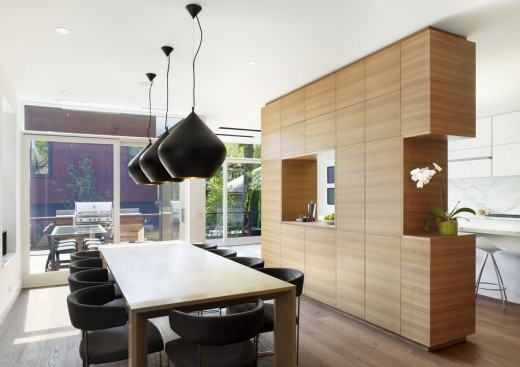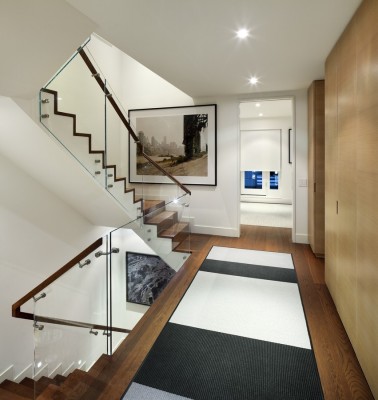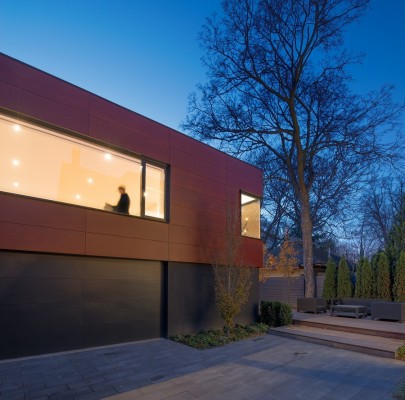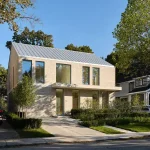Annex House in Toronto residence, Ontario property, Canadian home images, Building
Annex House in Toronto
Ontario Property: Canadian residential development design by Dubbeldam Architecture + Design
Design: Dubbeldam Architecture + Design
Location: Toronto, Ontario, Canada
Annex House in Toronto
1 Dec 2015
Annex House Toronto
When the client, a young couple, purchased this property with its two structures – the main building and coach house – both had been used as rooming houses for many years.
The client wished to convert the fragmented property back into a single family residence, suitable for their expanding family and optimized for entertaining, while taking advantage of the two buildings on the site. The distinct structures define an outdoor space that has been designed as a courtyard and outdoor extension of the kitchen and dining rooms. The courtyard evolves from season to season and from day to day; it is a quiet resting place, brunch patio, and reading sanctuary on the way to yoga in the coach house, coming alive with the kids’ after school activities or as guests arrive to a backyard barbeque.
On the interior, the open plan is divided by delineating elements other than walls that both define and connect spaces through materiality and openings. They create a dialogue between the spaces, frame specific views, and aid in defining the distinct character of each space. In the vestibule, a whitened oak screen is divided into solid, clear and translucent panels that allow curated views into the other rooms.
The ground floor is organized around a central volume that disguises storage, ductwork, and structural elements, while featuring a linear gas fireplace, niches for display and seating. As the wood clad volume wraps to the dining room, cabinets become built-in benches, providing casual seating when entertaining larger groups. Contained within the centre of this volume is a void – a discrete bathroom clad in white marble with floating fixtures and a customized stone vanity – conceived to be luminous and smooth like the interior of a shell. In contrast, the volume’s exterior surface is articulated in a play of closed and open sections, and clad in white oak and rosal limestone that wraps around its entire surface.
Towards the rear of the house, a secondary floor to ceiling millwork volume clad in walnut is positioned between the dining and kitchen areas. Incorporating cleverly-located perforations to allow for views, conversation and exchange between the two spaces, this volume houses a bar, wine fridge, storage and a TV visible from the kitchen, concealed behind panels that pivot, raise and slide open.
The horizontal grain of the wood directs views to the large openings at the rear and beyond to the courtyard and coach house. As the spaces of the interior are joined through views and materials, the coach house and house are intimately connected in the same fashion. Each is clad in a different warm tone of wood veneer fiber cement panels with aligning seams and window openings, allowing plentiful views between them.
A whitened oak wood screen defines the vestibule, while clear and translucent panes within the screen curate views of the 3-dimensional artwork by Patrick Hughes in the adjacent living room. The focal point here is the linear fireplace and custom mantel above, which allows the owners to display their treasured photos and artifacts.
A monumental 13 foot long island is the centerpiece of the kitchen, where the linearity of the contrasting materials (walnut, marble, custom aluminum cabinets) draw the eye to the backyard and coach house. Without using walls, the central walnut-clad millwork both separates and connects the cooking and eating spaces, through curated openings used for display and a bar counter.
Various free-standing and built-in millwork components create a dialogue between spaces and allow for easy entertaining.
The open view also frames the Edward Burtynsky photograph, which serves as a dramatic backdrop for the dining area.
The Statuario marble island and backsplash provide a rich counterpoint to the crisp horizontally-ribbed aluminum kitchen cabinets. The large doors and windows create a natural flow of movement and line of sight from inside to out, great for backyard entertaining and carefree monitoring of children.
The linear grain of the rift-cut walnut emphasizes the horizontality of the space and directs views toward the coach house and exterior. Attention to detail is carried through to the finer grain of product design – smaller components such as door handles are customized to the overall design of the interior, while a row of copper-lined Tom Dixon pendant lights above the custom-designed white oak dining table provide it with warm illumination.
Furniture elements are cleverly-disguised as overflow seating, but are also multi-purposed as much-needed storage
or conceal mechanical components within.
Annex House in Toronto, Ontario – Property Information
Location: Toronto, Ontario, Canada
Size: Main House – 4,224 s.f; Coach House – 1,640 s.f.
Architecture, Interiors, and Landscape: DUBBELDAM Architecture + Design
Project Team: Heather Dubbeldam, Oliver Dang, Jacob JeBailey, Bindya Lad
Photographs: Tom Arban and Bob Gundu
Annex House in Toronto images / information from Dubbeldam Architecture + Design
Location: Toronto, Ontario, Canada
Toronto Architecture
Toronto Architectural Designs – chronological list
Ontario Architecture News on e-architect
Toronto Architecture – Selection:
Royal Ontario Museum
Daniel Libeskind
Royal Ontario Museum building
Toronto University Multifaith Center
Moriyama & Teshima Architects
Toronto University Multifaith Center
Cascade House
Paul Raff Studio
Cascade House
Comments / photos for the Annex House in Toronto property design by Dubbeldam Architecture + Design page welcome.

